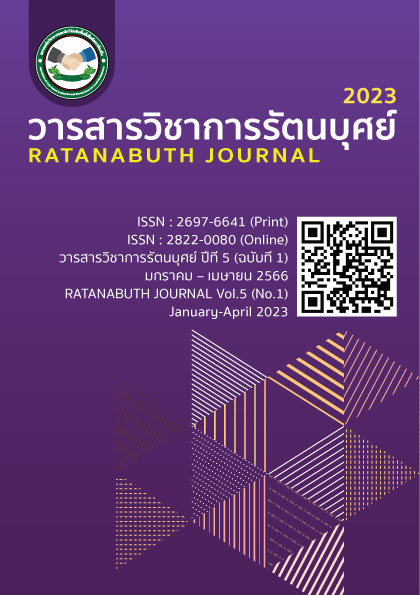Administrative Models Affecting Educational Management Effectiveness of Private Vocational Colleges in the Northeastern Region Administrative Models Affecting Educational Management Effectiveness of Private Vocational Colleges in the Northeastern Region
Main Article Content
Abstract
This research article aims to 1) study the educational management level, 2) study the educational management model, and 3) confirm the educational management model that affects the educational management effectiveness of private vocational college personnel in the region. Northeast using a combined study method The study population consisted of administrators and personnel of private vocational colleges. The research tools used were a 5-point estimation questionnaire, statistics used were basic statistics, analytical statistics, and exploratory indicators. Confirmatory component analysis statistics and analyze multiple regression analysis
The results of the study were as follows: 1) the level of educational administration of private vocational college personnel; The overall level was at a moderate level, consisting of quality management (mean =3.48), internal educational quality assurance. (mean=3.35), human resource management (mean=3.22), educational plan preparation (mean = 3.29), academic leadership (mean = 3.17), and educational atmosphere (mean = 3.11). 2) The results of confirming the consistency of the management model of the private vocational colleges generated in accordance with the empirical data satisfactorily Chi-Square=502.64, df = 433, P-value = 0.01152, RMSEA = 0.023, SRMR = 0.039, NFI = 0.98, NNFI =1.00, GFI = 0.91, AGFI = 0.88, CFI = 1.00 and 3) The educational management model that affects the educational management effectiveness of private vocational college personnel in the northeastern region consists of school atmosphere. preparation of study plans Academic Leadership Quality Management human resource management quality assurance which is a predictor of the effectiveness of education management at 70 percent.
Article Details

This work is licensed under a Creative Commons Attribution-NonCommercial-NoDerivatives 4.0 International License.
References
ธีระ รุญเจริญ. (2553). ความเป็นมืออาชีพในการจัดและบริหารการศึกษายุคปฏิรูปการศึกษา (ฉบับปรับปรุง) เพื่อปฏิรูปรอบสองและประเมินภายนอกรอบสาม. กรุงเทพฯ : ขาวฟาง.
พรชัย เจดามาน นิตยาพร กินบุญ และไพฑูรย์ พิมดี. (2560). ทรัพยากรมนุษย์: มิติการบริหารจัดการศตวรรษที่ 21 อย่างยั่งยืน. กรุงเทพฯ: สูตรไพศาลบิวเดอร์.
ภารดี อนันต์นาวี. (2555). หลักการ แนวคิด ทฤษฎีทางการบริหารการศึกษา. พิมพ์ครังที 4.ชลบุรี : มนตรี.
รังสรรค์ อ้วนวิจิตร. (2554). รูปแบบความสัมพันธ์เชิงสาเหตุประสิทธิผลของโรงเรียนประถมศึกษาขนาดเล็ก. วิทยานิพนธ์ปริญญาปรัชญาดุษฎีบัณฑิต. กรุงเทพฯ: มหาวิทยาลัยคริสเตียน.
วรรณรัตน์ วัฒนานิมิตกูล. (2557). การศึกษาทัศนคติของผู้ประกอบการต่อการส่งออกทุเรียนไทยไปตลาดสาธารณรัฐประชาชนจีน. สยามวิชาการ ปีที่ 15, 1(24).
สงบ ลักษณะ. (2541). แนวทางการประกันคุณภาพการศึกษา. วารสารข้าราชการครู. 18 (สิงหาคม – กันยายน 2541). 2-7.
สำนักงานคณะกรรมการการศึกษาขั้นพื้นฐาน. (2551). แนวทางการดําเนินงานการมีส่วนร่วมการบริหาร จัดการศึกษา. กรุงเทพฯ : โรงพิมพ์ชุมนุมสหกรณ์การเกษตรแห่งประเทศไทยจํากัด.
สำนักงานคณะกรรมการการศึกษาขั้นพื้นฐาน. (2556). ระบบจัดเก็บขอมูลนักเรียนรายบุคคล. สืบค้นจาก: http://portal.bopp-obec.info/obec56/.
สำนักงานคณะกรรมการการอาชีวศึกษา. (2555). มาตรฐานการอาชีวศึกษา พ.ศ. 2555 เพื่อการประกันคุณภาพภายในสถานศึกษา. กรุงเทพฯ : สำนักงานฯ.
สำนักงานคณะกรรมการศึกษาแห่งชาติ. (2554). บทสรุปและข้อเสนอแนะเชิงนโยบายและเชิงปฏิบัติจากผลการประเมินคุณภาพภายนอกรอบสอง (พ.ศ. 2549-2553) ของสถานศึกษาสังกัดสำนักงานคณะกรรมการการศึกษาขั้นพื้นฐาน. กรุงเทพฯ: โรงพิมพ์ชุมนุมสหกรณ์การเกษตรแห่งประเทศไทย.
สุพจน์ อินหว่าง และกัญญามน อินหว่าง. (2556). การจัดการทรัพยากรมนุษย์. พิษณุโลก: มหาวิทยาลัยพิษณุโลก.
เสาวนีย์ บุญธรรม. (2558). การศึกษาความสัมพันธ์ระหว่างบรรยากาศองค์การกับประสิทธิผลของโรงเรียน สังกัดสำนักงานเขตพื้นที่การศึกษาประถมศึกษานครราชสีมา เขต 1. วิทยานิพนธ์ปริญญาคุรุศาสตร มหาบัณฑิต. นครราชสีมา : มหาวิทยาลัยราชภัฏนครราชสีมา.
Comrey, A. L., & Lee, H. B. (1992). A First Course in Factor Analysis (2nd ed.). New Jersey:Lawrence Erlbaum Associates. Retrived October 15, 2009, from http:// www.ingentaconnect.com/content/apl/lcbi.
Halpin, A.W, and Croft, D.B. (1963). The Organizational Climate Of School. Chicago: University of Chicago Press.
Kline, R.B. (2005). Principles and Practice of Structural Equation Modeling (2nd Ed). New York: The Guilford Press.
Segers, MSR., & Dochy, F.J.R.C. (1996). Performance Indicators. Retrieved March, 17, 2006.from http:// www. Positive. Quality Assurance in Higher Education: TheoreticalConsiderations and Empirical Evidence. Studies in Educational Evaluation, 22, 2,115-37.
Sushila D. R. (2007). HRM Practices and Employee Performance in Cooperatives: Direct and Indirect Relationship. Malaysian Journal of Co-operatives Management, 4, 32-49.


